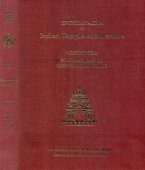Kshatrapa, Kṣatrapa, Kshatra-pa: 8 definitions
Introduction:
Kshatrapa means something in Hinduism, Sanskrit, the history of ancient India, Hindi. If you want to know the exact meaning, history, etymology or English translation of this term then check out the descriptions on this page. Add your comment or reference to a book if you want to contribute to this summary article.
The Sanskrit term Kṣatrapa can be transliterated into English as Ksatrapa or Kshatrapa, using the IAST transliteration scheme (?).
Alternative spellings of this word include Kshatrap.
India history and geography
Source: academia.edu: The Chronology of Ancient Gandhara and BactriaThe origin of the Western Saka Kshatrapas.—Saka Kshatrapas became the military officials of Indo-Pahlavas (Gondopharid dynasty) after the fall of Indo-Scythian empire around 766 BCE. Jain sources tell us that Kalakacharya wanted to take revenge on Gardabhilla, the king of Ujjain. He crossed Indus river around 724 BCE and met many Saka satraps. He motivated them to get rid of their inferior status under Indo-Pahlava kings and invade on Ujjain to become independent kings. Kalakacharya succeeded in his mission and brought 95 Saka satraps to Ujjain. These Saka satraps defeated Gardabhilla and became the kings of Ujjain in 723 BCE. They reigned for 4 years but Vikramaditya I drove them away and founded a powerful Malava kingdom in 719 BCE. It appears that these Saka satraps (kshatrapas) did not go back to their native place after the defeat. One group of these satraps (led by the forefathers of Chashtana) settled in the region close to Girnar, Gujarat whereas another group (led by the forefathers of Kshaharata Bhumaka) settled in the region close to Nasik, Maharashtra.
Source: Cologne Digital Sanskrit Dictionaries: Indian Epigraphical GlossaryKṣatrapa.—(IE 8-2, 8-3; ML; HD), feudatory title of foreign origin; Old Persian Khshathrapāvan, ‘a provincial governor’; a Satrap. See CII, Vol. II, pp. xxxiv, 23, 28; Vogel, Ant. Ch. St., p. 166. See Mahākṣatrapa. Note: kṣatrapa is defined in the “Indian epigraphical glossary” as it can be found on ancient inscriptions commonly written in Sanskrit, Prakrit or Dravidian languages.

The history of India traces the identification of countries, villages, towns and other regions of India, as well as mythology, zoology, royal dynasties, rulers, tribes, local festivities and traditions and regional languages. Ancient India enjoyed religious freedom and encourages the path of Dharma, a concept common to Buddhism, Hinduism, and Jainism.
Languages of India and abroad
Sanskrit dictionary
Source: DDSA: The practical Sanskrit-English dictionaryKṣatrapa (क्षत्रप).—a governor, satrap; (a word found on coins and inscriptions.)
Derivable forms: kṣatrapaḥ (क्षत्रपः).
Kṣatrapa is a Sanskrit compound consisting of the terms kṣatra and pa (प).
Source: Cologne Digital Sanskrit Dictionaries: Monier-Williams Sanskrit-English DictionaryKṣatrapa (क्षत्रप):—[=kṣatra-pa] [from kṣatra] m. a governor, Satrap (a word found on coins and in [Inscriptions]) (cf. mahā-kṣ.)
[Sanskrit to German]
Sanskrit, also spelled संस्कृतम् (saṃskṛtam), is an ancient language of India commonly seen as the grandmother of the Indo-European language family (even English!). Closely allied with Prakrit and Pali, Sanskrit is more exhaustive in both grammar and terms and has the most extensive collection of literature in the world, greatly surpassing its sister-languages Greek and Latin.
Hindi dictionary
Source: DDSA: A practical Hindi-English dictionaryKṣatrapa (क्षत्रप) [Also spelled kshatrap]:—(nm) a satrap.
...
Kannada-English dictionary
Source: Alar: Kannada-English corpusKṣatrapa (ಕ್ಷತ್ರಪ):—
1) [noun] a particular section of a country, state, etc. divided off as for administration; a division.
2) [noun] an officer having administrative authority over such a division.
--- OR ---
Kṣātrapa (ಕ್ಷಾತ್ರಪ):—[noun] an officer having administrative authority over a division of a country or state.
Kannada is a Dravidian language (as opposed to the Indo-European language family) mainly spoken in the southwestern region of India.
See also (Relevant definitions)
Starts with: Kshatrapati.
Ends with: Mahakshatrapa, Nakshatrapa.
Full-text (+1): Mahakshatrapa, Kshatrap, Barnasa, Dahanuka, Iba, Tapi, Damana, Parada, Nava, Karabena, Satrap, Khshathrapavan, Sertip, Junagadh, Shalivahana, Candramsha, Ramacandra, Arjunayana, Sadacandra, Vamacandra.
Relevant text
Search found 10 books and stories containing Kshatrapa, Kṣatrapa, Kshatra-pa, Ksatrapa, Kṣatra-pa, Ksatra-pa, Kṣātrapa, Kṣātra-pa; (plurals include: Kshatrapas, Kṣatrapas, pas, Ksatrapas, Kṣātrapas). You can also click to the full overview containing English textual excerpts. Below are direct links for the most relevant articles:
Expansion of the Gupta Empire < [July-August, 1929]
The Siva Linga: Conceptual, Iconographical and < [January – March, 1996]
The Garuda Purana (by Manmatha Nath Dutt)
Chapter XXIV - The worship of Ganapati < [Agastya Samhita]
Charaka Samhita and Sushruta Samhita (by Nayana Sharma)
The identity of Caraka < [Chapter 1]
Matangalila and Hastyayurveda (study) (by Chandrima Das)
Natyashastra (English) (by Bharata-muni)
Part 8 - The Date of the Nāṭyaśāstra < [Introduction, part 1]
Impact of Vedic Culture on Society (by Kaushik Acharya)
Copper-plate Charters < [Chapter 6]
Religious tolerance of kings of northern India < [Chapter 4]
Related products
